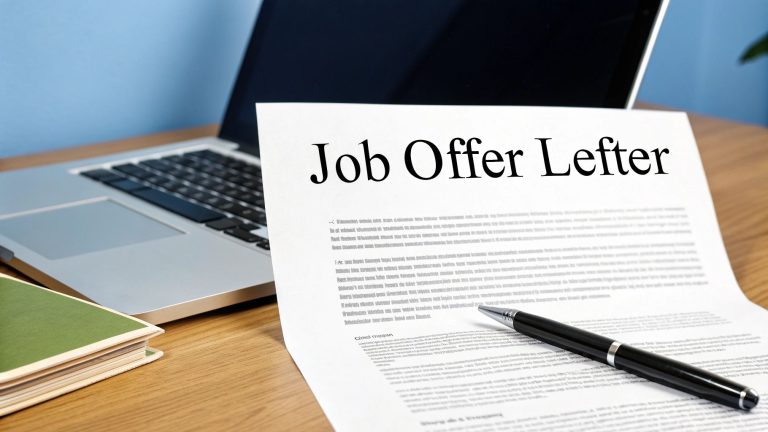Picture this: you’re excited about a company’s mission but there’s no job posting. What do you do? A letter of interest might be your secret weapon and is a huge part of professional writing.
If you’re wondering how to write a letter of interest that stands out, you’re in the right place. Over the next few minutes, I’ll walk you through each step so you can craft a proactive outreach that lands on the right desk.
| Letter type | Purpose |
|---|---|
| Letter of interest | Reach out to a company without specific job openings |
| Cover letter | Apply for a particular advertised role |
Step 1: Prepare your header
Start with a classic block format on the top left margin. This makes your letter look professional and easy to scan. Include these parts in order:
- Your contact details
- Full name
- Street address
- City, state, ZIP code
- Phone number
- Email address
- Date (month day, year)
- Recipient’s information
- Name and title
- Company name
- Street address
- City, state, ZIP code
Keeping everything left-aligned (no indents) gives a tidy, business-style appearance. Use a standard font like Arial or Times New Roman at 11 or 12 points.
Step 2: Write your greeting
Addressing the right person shows you did your homework. If you know the hiring manager’s name, use it:
Dear Ms. Patel,
Dear Mr. Thompson,
No name? Try a general but polite option:
Dear Hiring Manager,
Dear Human Resources Director,
Unsure which title fits? A quick LinkedIn search or company website check usually turns it up. Avoid “To whom it may concern” unless you have zero other choice.
Step 3: Craft opening paragraph
Your first paragraph sets the tone, so keep it succinct and engaging. Mention how you discovered the company and why you’re reaching out. For example:
I recently read about your plans to expand into renewable energy. As a project coordinator with three years of experience in solar initiatives, I’d love to explore how I can support GreenWave Solutions’ next phase.
Here’s the thing, you’re not applying to a listed job. You’re starting a conversation. So be clear about what drew you in and what value you bring.
Step 4: Highlight your qualifications
In the body of your letter, pick two or three key achievements that match what you know about the company’s needs. Don’t repeat your entire resume. Instead, elaborate on the most relevant points (University of Washington):
- Managed a cross-functional team to deliver a $500K solar project two weeks ahead of schedule
- Increased donor engagement by 30 percent through targeted community outreach campaigns
- Streamlined reporting processes, saving my team 10 hours per week on data entry
Bullet points can boost scannability. Follow each with a brief sentence tying it back to the organization’s goals.
Step 5: Demonstrate company knowledge
Before penning your letter, dive into the company’s mission, values, and recent projects (Resume Trick). Then weave those insights into your message. For example:
I admire GreenWave Solutions’ commitment to community-driven energy programs, especially your recent partnership with CitySpark. My background in engaging local stakeholders could help deepen those connections.
Showing you get what makes the company tick tells hiring teams you’re serious and proactive. It also sets you apart from generic outreach.
Step 6: Conclude with a call to action
Wrap up by expressing your availability and eagerness to discuss possibilities. Keep it friendly but clear:
Thank you for considering my interest. I’m available for a brief call or coffee chat at your convenience. You can reach me at (555) 123-4567 or [email protected]. I look forward to exploring how I can contribute to GreenWave Solutions’ upcoming projects.
A direct next step invitation makes it easy for the reader to respond.
Step 7: Format and proofread your letter
A flawless presentation gives you instant credibility. Before you hit send, check for these common pitfalls:
- Using a generic template that screams “copy-paste”
- Ignoring title and company details (make sure names are correct)
- Writing a four-page novel instead of a one-page letter
- Repeating your resume verbatim instead of adding context
- Typos or grammatical errors (have a friend review it)
Save your letter as a PDF named “JaneDoe_LetterOfInterest.pdf” to preserve formatting across devices.
Key takeaways
- Use block style header with your and the recipient’s contact info
- Address the right person and avoid outdated salutations
- Open by explaining why you’re reaching out and what drew you in
- Highlight 2–3 relevant achievements that match company goals
- Show you’ve researched the organization’s mission and projects
- End with a clear call to action and your availability
- Keep it to one page, proofread carefully, and send as a PDF
Now it’s your turn: draft your letter of interest and take control of your career journey. Got a question or a success story? Share it in the comments below so everyone can benefit.





